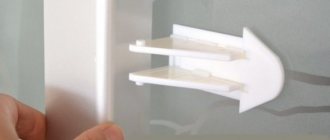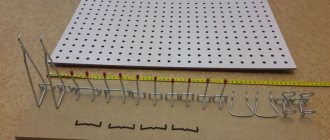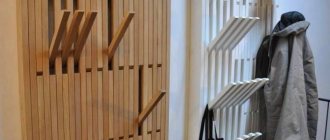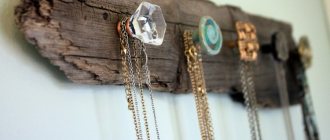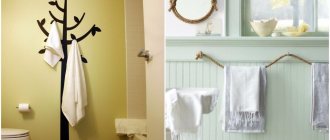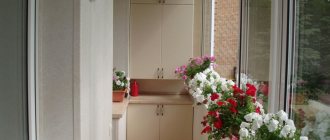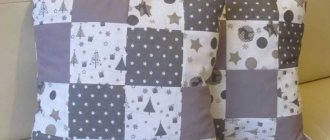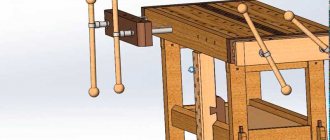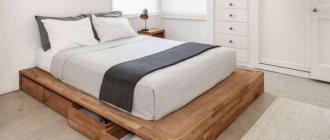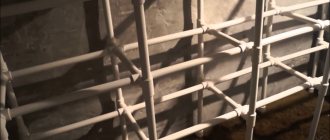Clothes dryer
In most apartments there is no way to dry washed clothes in the rooms, so you have to use the balcony. In summer, this method is generally advantageous, because under the sun's rays, clothes of any density dry almost instantly. In winter it is more difficult; a prerequisite for drying things is to have a glazed balcony, since otherwise they will only turn into ice.
But even in a glazed balcony, it is important to organize the clothes dryer in such a way that there is free access to the window, because it has to be opened regularly to ventilate the room. Otherwise, mold and dampness are inevitable.
Convenient clothes dryer for the balcony
In the cold season, you will still have to dry your clothes in the apartment, no matter how good the dryer on the balcony is. An excellent option to avoid this are batteries. In some apartments they are specially placed on the balcony in order to facilitate the drying process.
When buying an apartment, the balcony is not given the same attention as all other rooms. In fact, this room is irreplaceable, so if you see mold, unpleasant odor and dampness on the walls, immediately think about where the laundry will dry. If there are no options for organizing a dryer in the room, this will create many problems.
Outdoor option
Advice You should never delay repairing your balcony if you use this room for drying clothes.
When the first signs of dampness, mold and other unpleasant phenomena are detected, they must be eliminated immediately. Otherwise, after some time it will be impossible to use the dryer on the balcony.
Ceiling structure
A ceiling dryer on the balcony is an ergonomic solution. This model must be assembled after drying, which will free up more space on the balcony and not interfere with cleaning. At the same time, it can hold more things and accommodate a full set of double bed linen.
Dryers that are built into the ceiling can be divided into the following types:
- Built-in: the structure is firmly attached to the ceiling surface.
- Removable: after drying the washed items, you can remove the metal divisions, leaving only the fasteners on the ceiling. Ideal for a balcony with a low ceiling.
- Two-tier: the upper compartment is built into the ceiling, the lower compartment can be installed as needed.
This model is reliable, thanks to metal elements in the form of long pipes, which are subsequently mounted in holders.
The assembly is adjusted using a strong cord that pushes the accordion mount to the required distance. In this case, you can dry up to 25 kg of various items.
For each model you can purchase metal hangers for drying outerwear. They are easily attached to individual elements.
Finishing the loggia: review of interesting projects and tips on choosing finishing materials (185 photos + video)- Window sill on the balcony - 165 photos of modern ideas and options for using window sills
Sofa on the balcony - modern ideas and features of placing balcony sofas (180 photos)
Pros and cons of dryers
A dryer on the balcony is more of a necessary measure, rather than a whim. If there are no other options, then you have to occupy this room. However, this process does have positive aspects; it is not without reason that it has long been practiced in many developed countries:
- space in the apartment is saved;
- the laundry is ventilated, a pleasant smell of freshness appears;
- It’s easy to block children’s access to wet things - you can simply close the door;
- hiding laundry is also easy - you can simply curtain the window to the balcony.
Saves space in the apartment
These advantages are especially noticeable in those apartments whose balcony windows do not face the road, but the forest or other nature. No rinse aid will give things as much freshness and aroma as such a natural scent.
Advice If the balcony windows face the highway and other dusty places, it is best to dry clothes at night and early in the morning.
A clothes dryer on the balcony also has disadvantages. However, they are not so catastrophic as to abandon this process; it is important to simply know all the nuances and learn to adapt to them. Among the disadvantages of a balcony clothes dryer are the following factors:
Dependence on weather. If it rains and the window on the balcony is open or there is no window at all in the summer, most likely the washing will have to be repeated again. To avoid such situations, it is better to dry things when someone is at home and check the weather forecast in advance.
Linen must be hung very carefully
The smell of smoke. Some people use the balcony as a smoking area, so if neighbors below smoke and the balcony windows are open, the smell of smoke will certainly be absorbed into their clothes. And if they smoke from above, then ash may also fly into the window. To prevent such situations, it is better to use the dryer with the windows closed, and ventilate the room before and after.
Danger. No matter how strange it may sound, we still hear about cases where people fell out of a balcony window while hanging laundry, especially if they did it behind the balcony. In this regard, it is important to take safety precautions when also caring for small children.
Portable option
Note: In some countries, drying things outside the balcony (on the street side) is strictly prohibited by law. The authorities believe that this spoils the overall appearance of the city and creates an unfavorable impression among tourists.
What do we expect from a clothes dryer?
The time when clothes were dried outside on clotheslines is irrevocably gone. Now we don’t want to expose our personal belongings to others, we are afraid of theft of expensive things, we are afraid of wind with dust and rain. For these reasons, a great variety of devices have appeared that solve this problem within the premises.
Let's decide what we want:
- First of all, you need to assess the possible volume of laundry. This affects the capacity of the structure and the required load capacity of the device.
- Secondly, you should decide on the location of the dryer: on the balcony, in the bathroom, in the kitchen, in a separate room, or in the yard.
- Thirdly, it is necessary to choose the type of structure: will it be stationary, removable, mobile or transformable.
- Fourthly, we need to choose the material from which we will make a device for drying clothes. We briefly examined the set of requirements for a dryer. Now let's take a closer look at the possible options.
Aesthetics
Many people, especially women, worry that a dryer on the balcony can ruin their reputation in the eyes of guests and create a bad impression of the comfort in the apartment. If this moment worries you too, you can apply a few simple rules and tips. They will help organize the drying of things in such a way as not to spoil the overall appearance of the apartment.
Will not spoil the appearance of the balcony
As already mentioned, the practice of drying things on the street side of the balcony has long been outdated, and besides, such behavior is considered a sign of bad taste. Few people want their clothes, and especially their underwear, to be examined by strangers, while some, without hesitation, hang them out for everyone to see. Even if it is not possible to dry everything at once, you need to adapt to your circumstances and wash less, but more often.
In order to hide wet things from the eyes of guests, you need to take care of the presence of a curtain that would cover the window between the room and the balcony . It is desirable that it be dense and not see through. Some housewives find an original solution to this problem - they place a large climbing flower on the windowsill, which completely covers the entire glass, so that no one will guess that it is not just a houseplant, but also an important part of the interior.
Saving space on the balcony
It happens that it is not possible to close the curtain: if guests come during the day, then there must be daylight in the room. In this case, a simple rule that should always be followed when hanging clothes will be useful: intimate items, underwear should be located in the center, and everything else on the sides. Then sweaters, T-shirts and other large clothing will be a kind of barrier protecting intimate clothing from prying eyes.
Main advantages
A balcony or loggia is always a multifunctional space. It accommodates a seating area, mountains of unnecessary things, and various indoor plants, so there is simply no room for a standard clothes dryer.
In this case, many use a proven method: pulling clotheslines to dry clothes. After this, housewives may experience certain problems, namely uneven drying of things or low strength of the rope itself.
If you make a built-in dryer on the balcony, you can not only save space, but also reduce the humidity in the room itself.
The following advantages of this design are also highlighted:
- Washed items will be dried evenly, regardless of the weather conditions outside. At the same time, you don’t have to worry about them getting damp in high humidity.
- Metal fasteners can withstand large amounts of laundry.
- Some models have adjustable divisions, which will save even more space.
- There is no need to secure the laundry with clothespins, as it fits tightly to the dryer rails.
- Various price categories.
Clotheslines
The easiest way to organize a dryer on the balcony is to string ropes. At first glance, it seems that there is nothing complicated about this. But those who have ever had to waste time re-washing clothes because they were found on the floor with broken ropes know that this is not so.
The easiest way
To begin with, it is important to choose the right material - it should be light, but at the same time durable so that it does not wear out quickly. Also, it should not stretch like an elastic band and get dirty, because if the rope turns black, it is unlikely that any housewife will want to hang clean laundry on it. The most suitable materials, which are easy to find, are:
- metal cable wrapped in PVC;
- jute;
- polypropylene.
Metal cable
There are also standard materials that are inexpensive, but can serve you well for a while. However, their endurance is not so long, over time they begin to sag lower and lower, and they also quickly get dirty, so after that you immediately have to look for a replacement. These include :
- standard twisted rope, which is in greatest demand among residents of our country;
- plastic, which attracts attention with the variety of available colors.
To secure the rope to the wall, you have to make special structures with your own hands, since it is usually sold not as a set, but separately. To do this, you will need two slats, their length depends on how many rows will be located. They are attached opposite each other; for reliability it is better to use strong nails or special screw-in hooks.
Good choice of clothes dryer
Advice The easiest way is to first firmly tie the edge of the rope to the outermost nail, then stretch it in different directions, wrapping it around each nail on the slats. A strong knot is made on the last nail, as on the first.
The evolution of clotheslines – “Liana” dryer
There is a convenient, easy-to-install design on the household goods market - the Liana dryer. It consists of two functional units. One of them is attached to the wall, the other to the ceiling. A frame with rods on ropes is mounted on the ceiling. A holder for these cords is fixed on the wall. By moving them, you can raise and lower the clothes drying rods.
Wall-ceiling mount “Liana”
Note! The wall holder must be able to withstand the load of all the drying clothes, otherwise you simply will not be able to fix the rods in the desired position. The holder must be securely fastened.
The advantage of drying vines is the cascade arrangement of the rods. This allows clothes to dry quickly and evenly.
You can do the installation yourself. For this:
- Mark the location for attaching the brackets to the ceiling.
- Drill holes in these places using a hammer drill.
- Secure the brackets with self-tapping screws.
- In a position convenient for use, fix the cord holder on the wall with self-tapping screws.
- Take one barbell. Secure it in the structure by pulling a long cord through the left roller, and a long and short cord through the right one.
- Place height clamps (caps) on the ends of the cords.
Fastening element for installing a wall unit
The kit includes detailed installation instructions. Consider its provisions. After installation, check the operation of each rod.
Lianas
Linen vines look stylish and do not spoil the overall appearance of the balcony. In addition, in terms of strength and service life, such a dryer is several times better than simple ropes attached to slats. It belongs to the category of ceiling devices for drying things.
Lianas for linen
The vine is a frame equipped with cords and attached to a mechanism on rollers. One of the advantages of this model is that the length of each rope can be easily adjusted. Thanks to a special clamp, the rods can be easily fixed at the desired level.
Many note another advantage of the vine - it can be folded and in this position it takes up absolutely no space and does not attract attention to itself . The latest models are made so thinly that looking at them in assembled form, it is generally difficult to understand what it is.
long vine
Installation of the vine begins with the preparation of the fastening; it can be wooden beams or any other made of durable material. After this, you need to mark the place using a tape measure and a pencil. To install panels with rollers, you will need to drill into the previously installed fastening and drive a plug into it, and screw the panel on top.
After this, 1.5 m is measured from the floor and a bracket is attached, the ropes are alternately pulled through the panels with rollers. In this case, the short one is directed towards the fastening, and the long one clings to the roller opposite itself and descends along the fixed bracket. As a result, all ropes become the same length, stretched evenly.
Ceiling dryer
Ceiling dryers are more practical to use than wall-mounted ones, because they take up minimal space, while being very practical in functionality. Even ordinary clotheslines attached to slats also fall into this category. This demand is absolutely justified, because ceiling systems have a number of advantages:
- both the floor and walls of the balcony remain free, so you can move freely and arrange the necessary furniture;
- do not attract attention when there is nothing on them;
- It doesn’t require a lot of expense, and some of them can be done by purchasing only the necessary materials.
Most practical to use
One of the popular models of ceiling dryers are retractable systems called “accordion dryers”. The principle of operation of the mechanism is that the model is attached to the ceiling, and in order to hang laundry on it, it must first be lowered to the desired level.
There are different versions of the release system for pull-out dryers, the most popular of which is a mechanism that operates by pulling a string. It is enough to pull it down, and the structure immediately lowers; immediately after it is released, it stops. The structures themselves can be of completely different sizes and contain any number of ropes.
Often, in retractable ceiling dryers, thin pipes made of plastic or other material are available instead of ropes.
The disadvantage is the fragility
The only drawback of this ceiling model is its fragility . Most pull-out dryers are designed to weigh no more than 5 kg, but even then they often fail prematurely. Therefore, such ceiling models are suitable for small families who dry things in a small volume.
Advice Some housewives successfully combine several types of ceiling dryers. For example, you can use both a retractable dryer and Liana, which inherently also has a retractable mechanism. But you can combine them only if you have a large balcony, which is used only for drying clothes.
Ceiling models
Clothes dryers mounted on the ceiling of a balcony or loggia are one of the most popular models. They consist of two slats with crossbars or ropes attached to them, on which laundry is hung.
There are two main types of ceiling dryers for balconies:
- With independent suspension of each bar. The most popular models in this group are called “Liana” and GIMI Lift. This is the same design, it’s just that the manufacturers are Russian (Liana) or foreign. They are easy to use, as they allow you to lower and raise one bar at a time, and place them at different heights.
Clothes dryer with ceiling mounting - Single suspension for the entire structure. Several crossbars (from 2 to 6) are mounted on telescopic hangers. They can only be lowered and raised together.
The second option is easier to install, has a lower cost, but is less convenient. All planks are at the same height. This makes it difficult for laundry that is located closer to the wall or in the middle rows to dry. The second point: it is not so easy to lift a dryer loaded with wet laundry.
This is a “Liana” with a ceiling mount
Free-hanging dryers are a little more difficult to install. All crossbars are attached to two slats on the ceiling, but each of them has a rope, which allows you to lower/raise the rods for hanging laundry. So during installation, in addition to installing the crossbars on the ceiling, you also have to attach a plank to the nearby wall on which the ropes are fixed. The crossbars in ceiling dryers of this type can be made of plastic, steel coated with powder enamel (Gimi) or aluminum (Liana). You can find wooden crossbars from other manufacturers, but those listed above are represented by a large number of models.
Floor
A floor-mounted clothes dryer can be used not only for balconies, but also in any room, however, many simply do not have the space to place it in their room. These models are used mainly in cases where, for some reason, it is not possible to attach ceiling ones. In some apartments, the walls and ceilings on the balconies are so unreliable that it is not worth painting, so you have to do without using them.
Used not only on balconies
Floor dryers have their advantages, the main ones include:
1 Mobility . If you suddenly need to move the dryer from one place to another, or even temporarily to another room, this can be done without any problems. They are usually not heavy and can also be folded to make them easier to lift.
2 Variety of sizes. Floor dryers come in completely different sizes, so there is a suitable option for any family size. Also, such models are often used as an addition to ceiling ones; some attach a retractable model to the ceiling, and place a floor model underneath.
For different types of things
3 Option not to use . If you have attached a ceiling dryer, it is unlikely that you can easily remove it the first time you need it. However, floor dryers are more practical - they can be easily folded and put away, especially since when folded they usually take up little space.
4 Easy to attach . Unlike other models, these do not need to be screwed or otherwise secured using tools. All you need to do is simply press on the mechanism, and it will immediately open.
Types of floor
The most popular is the classic type, the mechanism of which resembles the principle of folding out an ironing board. The support consists of pipes crossed between each other, the shape of which resembles the letter “X”. Clothes are hung on pipes, of which there can be any number.
Stylish dryer option
When choosing a classic floor dryer, special attention should be paid to the strength of the tubes. Some cheap models are not designed to withstand a weight of more than 5 kg and it is better not to buy such ones, because even if someone accidentally leans on it, it will immediately break. It’s worth thinking about whether it’s really necessary to save money when purchasing, and then go to the store again a month later.
For families with small children
In families where there are small children, and, therefore, a large amount of clothes are washed, multi-tiered floor dryers will be practical. They are structures, often from floor to ceiling, on which pipes are placed. Outwardly, they look as if several classic models were stacked on top of each other.
Among the assortment of floor dryers, there are often Chinese models known for their fragility. To avoid buying them, you must carefully study the manufacturer’s instructions yourself, without trusting sellers.
Hanger
Hangers for drying clothes on the balcony are the only way to dry and store clothes in a natural position. This is especially practical for drying men's suits and other large items that should not be folded when wet. Everyone has at least once had to spend time smoothing out wrinkles that appeared as a result of drying things in the wrong way.
Convenient to dry men's suits
Drying hangers can be used as an auxiliary structure, that is, you can use a floor dryer and one at the same time, or combine it with any other models. Another advantage of this method of drying things is that you can use the means available in the house. The easiest way to build a dryer with hangers is this way :
- We are looking for a pipe of the required length; it must reach from one wall to another, and there must be room for fastening. An excellent option would be a hanger holder from a wardrobe. You can use the one that is no longer used in the closet, or you can purchase it separately; usually the holders are sold as separate spare parts in many furniture stores.
- We attach the pipe or holder to the walls. Some of them are attached directly to the ceiling; you just need to tighten the holders with screws. Using such designs, it is easier to choose the length, because it does not have to be from wall to wall, it can occupy half or any desired part of the ceiling.
- We select the required number of hangers and dry the clothes. Some people use the same ones on which clothes hung in the closet for this, but this is not advisable. It is better to have hangers separately for storing clothes in the closet and separately for drying.
It is possible to attach a hanger - this is sometimes not enough
Tip In furniture stores, in departments with ready-made clothes dryers, they sell special hangers made of moisture-resistant material. Their use is convenient and practical, because they can last a long time.
This will be interesting for you:
240+ Photos of finishing options for the Balcony inside: Beautiful interior with your own hands
Wall dryer
Wall-mounted dryers can be used in different cases: if it is not possible to use a ceiling dryer, if the ceiling on the balcony is too high, so it is not easy to reach the rope, and for other reasons. This category consists of various models that differ in design, mounting method and other parameters.
Inertial
When folded, these dryers are very compact, so there are no problems with storing them. Inertial models consist of two parts :
- Frame. Equipped with a drum with springs that tensions the cord and, if necessary, hides it inside. Thanks to this, good tension is ensured, so that the cord does not sag, and even over time, the clothes still dry at the desired level, and do not interfere with walking.
- Fastening. It can use either hooks attached on the other side or a bar. The mount is permanently present on the wall, and the body is put on it when necessary to dry clothes.
The inertial option is good for a balcony with a high ceiling
The cost of inertial clothes dryers varies, but cheaper models are less practical - over time, the cords on them still begin to sag, so that the tension becomes not the same as it was originally. On more expensive models, this problem does not arise, because the housing drum is equipped with a tension function, so as soon as the cords begin to sag, you can immediately use it.
Console
These wall-mounted dryers are even more compact than inertial dryers. If you need that immediately after drying there is no trace of ropes and cords left, this option will be suitable for you. When it is closed, you can see a small plank on the wall, no more than 10 cm wide, and its length can be different, depending on the model you choose.
They are even more compact than inertial ones
When a cantilever wall dryer is unfolded, tubes arranged in rows extend out. You can either simply throw clothes on them, or fasten them with clothespins. Like inertial models, such models are not designed for drying large amounts of laundry; it is usually recommended to weigh no more than 5 kg.
Sliding dryer
If you need a wall-mounted clothes dryer on the balcony, but the permissible weight does not suit you, sliding dryers are an excellent option in this case. Standard models can withstand a weight of no more than 10 kg, but if necessary, even more durable models can be found.
The sliding dryer is a structure made of metal pipes, which explains its strength. When the system is folded, it takes up very little space, since the pipes themselves are thin. In order to use the dryer, you need to open it - just grab the outer pipe and pull it towards you.
In wooden version
As a result, the design, which when folded seemed like one continuous metal pipe, turns into a multi-tier drying rack on which you can place many things. Considering that a sliding dryer is designed to carry more weight than inertial and cantilever dryers, it is necessary to pay due attention to fastening. For this, both dowels and screws can be used, but the main thing is to ensure powerful fixation.
Types and features of clothes dryers
All drying structures are divided into two types: portable and stationary. Portable ones are more convenient because they can be folded and put away so they don’t get in the way. It is better to place stationary drayers where they will not interfere with residents. For these products, it is best to choose a bathroom or balcony.
By type of location, dryers are divided into:
- floor - portable design options;
- wall-mounted - can be folding, sliding or stationary;
- ceiling - are a system of brackets and ropes attached to the ceiling;
- wall-ceiling - usually attached to the ceiling with brackets, and to the wall with a fixing bracket.
Ceiling clothes dryers for balconies
Externally and in terms of technical characteristics, dryers of this type are almost no different from wall-mounted ones, however, they are attached not to the wall, but to the ceiling, thereby saving space on the balcony. They can have different lengths
, also during installation, monitor the position of the rack; if it is too low, the laundry may get dirty.
The slats are made of metal and have anti-corrosion properties, but at the same time, it is extremely difficult to hang small items of laundry on these thick panels.
The most optimal option in terms of application is a dryer in the form of a vine
, which is equipped with a rigid rack frame. Cords are pulled from the slats through a roller mechanism. A clamp is installed on the wall, which holds the slats at the level that is convenient for you, and then with its help the bar is raised and the cord is secured. When the dryer is not needed, the slats rise directly to the ceiling and do not interfere with anyone at all.
Which option to choose
Before choosing a specific type, it is useful to familiarize yourself with general information about the types of linen devices. Based on location, devices are available in two types:
- Outdoor dryers. A simple frame is fixed to the outside of the balcony railing, and a clothesline is pulled on rollers between the two profiles. The outdoor option is relevant for unglazed rooms, so as not to clutter up a small space, but wet laundry can get wet in the rain.
- Internal devices. The system allows you to implement drying in any weather, if you choose the optimal type from a wide range of drying structures. Hanging options save space; stationary dryers (folding or sliding) occupy almost the entire space of the balcony.
The multifunctional device can be mounted on a wall or ceiling, but modern housewives choose the Liana ceiling model. Dryers can also be installed on the balcony floor or suspended or extended. The ease of use of drying systems and affordable cost are ensured by the use of modern materials; individual units can be folded for discreet storage.
Selection options
A clothes dryer for a balcony is selected not only by design, but also by parameters:
- number of rods and their length;
- rod material;
- bracket material.
Everything is clear from the materials. The best, but also the most expensive, is stainless steel. Just don't confuse it with chrome steel. As a rule, chrome plating wears off very quickly, after which the metal begins to rust.
Ordinary powder-coated steel behaves quite well, but only if the technology was not violated during painting. Otherwise, rusty spots will also appear.
The combined option is very good: the load-bearing parts of the structure are made of powder-coated steel, and the lintels on which clothes are hung are made of plastic. This type of dryer can be called optimal in terms of price/quality ratio.
Modern plastics are a fairly durable material that can withstand the load of laundry, it is not very expensive and does not change its performance characteristics for a long time.
But in load-bearing structures, especially at the junction of the legs of folding floor models, the presence of plastic is undesirable. This is still too much of a load for plastic.
The set of characteristics will determine how convenient or not it is to use a particular model. For example, for drying bed linen, rods at least 2 meters long are optimal. In this case, any part of the double set can be hung without folding.
The amount of laundry that can be hung at one time is determined by the total length of the rods.
It is usually in the description, but if not, then you can multiply the number of rods by the length. So we get the same characteristic. Here, of course, the larger the number, the more laundry you can hang. But, on the other hand, the more space on the balcony or loggia will need to be allocated for the dryer.
Electric
A couple of decades ago, no one had heard of electric dryers, but today you can buy them in many stores. These designs consist of a bar with rays emanating from its center. The beams usually have different sizes, large ones are used for drying larger items, and small ones are used for smaller ones.
At the bottom of the electric dryer there is a device that supplies hot air. The cost of such models is higher than that of others; the main factor influencing it is the material. Typically electric dryers are:
- aluminum is the cheapest option, but it does not last long, since this substance quickly oxidizes, and rusty stains remain on clothes;
- made of stainless steel - a more expensive option, but at the same time more durable;
- steel ones are the most durable and reliable models, the only drawback of which is their high cost.
For those who are always in a hurry
Advice The most popular electric dryers are made of stainless steel, because they are more expensive than aluminum ones and have good strength. However, when purchasing, you must carefully study the instructions, since unscrupulous manufacturers may add an admixture of aluminum, so that over time the structure will begin to oxidize and become unusable.
General installation rules
- Think about what your weight limit is. Remember that if you always load the structure to the maximum, weighing the maximum permissible weight, then its service life will be significantly reduced. It is better to take a model with a weight reserve; if you usually dry several kilograms of laundry, then a dryer with a permissible weight of five kilograms will be enough.
- Carefully consider the location of the dryer, as some models are mobile and easy to move, while others are simply not possible. Draw a plan on the wall or ceiling and think through all the little things: try opening a window to see if it will interfere with the structure and whether there will still be a passage.
Installation is quite simple
- If you are planning to repair your balcony soon, then you should wait to install a clothes dryer, since some structures cannot be reattached after removal. If the apartment, including the balcony, is designed in a certain style, then you will have to pay attention to the design of the dryer so that it does not spoil the overall appearance.
- If you have children, be sure to consider dryer safety. For example, if the wall model is placed too low, the child may be able to reach it. As a result, it will break, but what is even more dangerous, he may get injured.
DIY dryer
If you don’t see the point in spending money on purchasing something that you can do yourself, try making a dryer for the balcony with your own hands. At the same time, if you have never dealt with such work, it is better not to take risks. The easiest way to make a design yourself consists of several stages:
- We attach two planks of wood or metal on walls opposite each other.
- We attach ring-screws to them; how many ropes are needed, so many pairs of screws are needed.
- We make small holes for the screws, the diameter of which should be slightly smaller than the holes themselves.
- We screw in the screws, it is important to ensure that they are fastened firmly.
- If there are empty gaps in the places where the screws are screwed in, they must be sealed with ordinary putty or other means to impart strength to the structure.
- We stretch the rope, threading it through the prepared ring-screws, and secure it with strong knots.
Easy to do it yourself
It’s better not to skimp on a skein of rope; it should be strong and durable enough so that you don’t have to buy a new one in the near future. When tightening, you need to take into account the “golden mean” - it should not sag, but too much tension will lead to it simply breaking.
Tip When making a dryer with your own hands, you can take into account all the nuances of your own balcony, free space, quality of walls and ceiling and other features. If you don’t have time to bother, then you can find ready-made models from ready-made options by considering different options.
Thus, using clothes dryers on the balcony has certain disadvantages : dependence on the weather, the possibility of dust contamination, and the risk of absorbing the smell of cigarette smoke. At the same time, the advantages of the designs outshine all the disadvantages: you can choose a mobile model with any convenient mounting - on the wall, ceiling, floor. At the same time, you can decide for yourself how much and what space the dryer will take up, and also choose any design and even color.
Outdoor dryer
A common option among typical Soviet-built apartment buildings. Due to the fact that in those days balconies were built without a parapet, many used a steel “threshold” as the basis for metal fastenings.
Modern balcony - beautiful real design options for balconies and a combination of the best styles (video + 160 photos)- Finishing a balcony with stone - 155 photos of ideas for decorating and decorating a balcony with artificial and natural stone
Balcony layout - modern real ideas for design and decoration of a balcony (video + 165 photos)
They were strung with ropes and used as an external clothes dryer. Today, this method is still relevant.
For modern loggias, built-in accordion models are used. Strong steel arches up to 80 cm can withstand up to 10 kg of laundry. It can also be used in the absence of a balcony, using the space under the window.
Plastic removable structures are suitable for drying a small amount of things.
